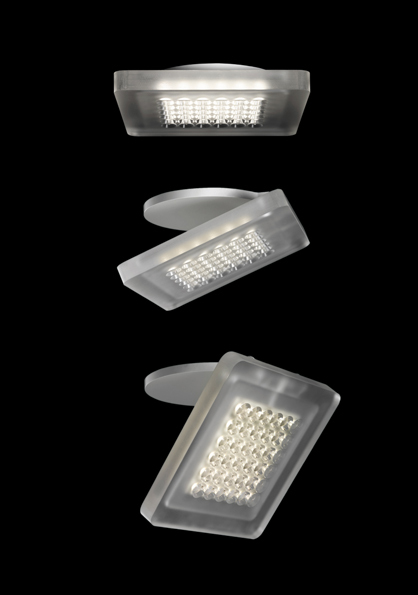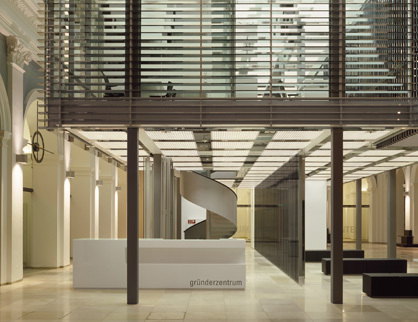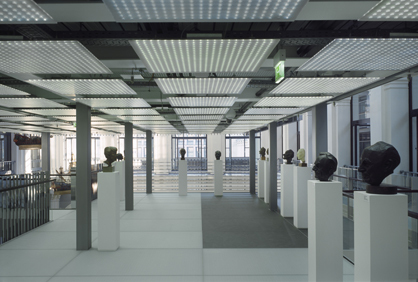LED.next technology and “Green Light”
Text by con:text
Leinfelden-Echterdingen, Germany
05.05.08
“The LED is the light source of the future” is the credo of the Nimbus Group, which is presenting itself at this year’s “Light + Building” fair in Frankfurt with an extensive and powerful LED range based on LED.next technology.
“The LED is the light source of the future” is the credo of the Nimbus Group, which is presenting itself at this year’s “Light + Building” fair in Frankfurt with an extensiveand powerful LED range based on LED.next technology. “Intelligent” system components developed by Nimbus and a technically mature electronic lighting control make energy-efficient light-emitting diodes even more thrifty and long-lived than they already are anyway. They signify a further important step in the direction of active energy saving. Nimbus gives the name of “Green Light” to this concept.
LEDs emit warm and atmospheric light
Even two years ago, Nimbus managing director stated that only superlatives could be used to describe the advantages of LED technology. Since then, he had done intensive development work with his company – and realises that his original expectations of the potential of LED lighting are far surpassed. What was scarcely conceivable two years ago has now become a fact thanks to the new Nimbus LED luminaires: the light colour emitted by LEDs can be compared to the warm light of the traditional incandescent bulb. The new LEDs also compare well with halogen. Just like halogen, they emit directional light, but by contrast they also brighten up all room-limiting areas – an aspect that may also crucially influence whether you feel wellbeing in a room or whether what you feel is rather more discomfort. It is also possible to realise differentiated lighting moods and dynamic lighting scenarioswith LED luminaires which, for example, correspond to the impression created
by clouds passing by – thus hinting at pleasant, natural light.
Differentiated lighting moods and dynamic lighting scenarios
“Intelligent” electronics supports active energy saving
“Intelligent electronics” is a significant innovation in the LED range. This is located in an extremely small and hardly visible motion detector. When motion is no longer perceptible, the system automatically dims down to 20% standby light output after three minutes – a measure perceived as being a pleasing one provided you are not immediately in the dark. A certain brightness in the building also conveys a positive feeling. When the area is entered again, the first luminaire responds, lights up immediately to 100 percent and passes on this information to the next luminaires in the room. Thanks to this option, the Q modules and all luminaires from the extensive Nimbus programme are predestined for use in the contract bracket – and the same goes for their further excellent properties: 50,000 hours useful life, wide-ranging freedom from maintenance, reduced power consumption and low heat development.
Q modules also available as a spot and in a watertight variant
The lens technology developed by Nimbus is an important characteristic of LED.next technology. In the case of the “Q” modules, it enables various kinds of light distribution: wide-angled, down-lighting or asymmetrical. Maximum flexibility is manifested by the “Q36 Spot”, which is capable of continuous rotation and swivelling and which enables accentuated illumination. “Q 36 Aqua” is used outdoors and in moist zones. With these variants, the possibilities of use of the Q modules have become almost boundless. As far as the future of LED is concerned, the managing director of Nimbus and his ten-member design team are convinced: “Despite the enormous progress we have made, we are still looking at largely unexplored terrain, especially as regards the great application possibilities of LED luminaires”.
Q 36 Spot module. The acrylic glass LED module that rotates and swivels continuously completes the Q family and serves the purpose of accentuated lighting.

Q 36 Spot module. The acrylic glass LED module that rotates and swivels continuously completes the Q family and serves the purpose of accentuated lighting.
×LED means being able to work even more intensively with light in architecture
Stefan Behnisch, from Behnisch Architekten, who made complete use of the LED modules (Q 400) from Nimbus in the “house within a house” in Hamburg’s chamber of commerce, also starts to enthuse when it comes to LEDs: “If you consider LEDs, you have only small light spots. But you can add to them almost at random, you can switch them adjacently, you can process them in areas, and you can recess them within surfaces, thus arriving at large, luminous elements in almost any degree of diversity and luminous intensity. For us architects, a field has been opened up that allows us to work with light even more intensively than before.” Behnisch Architekten and the Nimbus Group are currently planning a further LED project for a large science complex for Harvard. Among other things, this concept provides for LEDs integrated in the furnishings and further innovative solution approaches.






